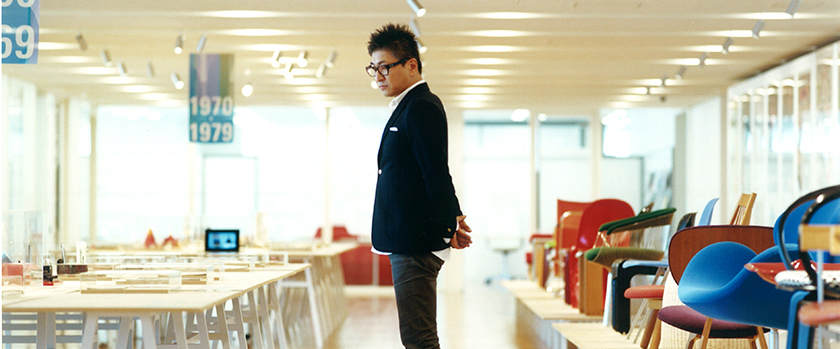
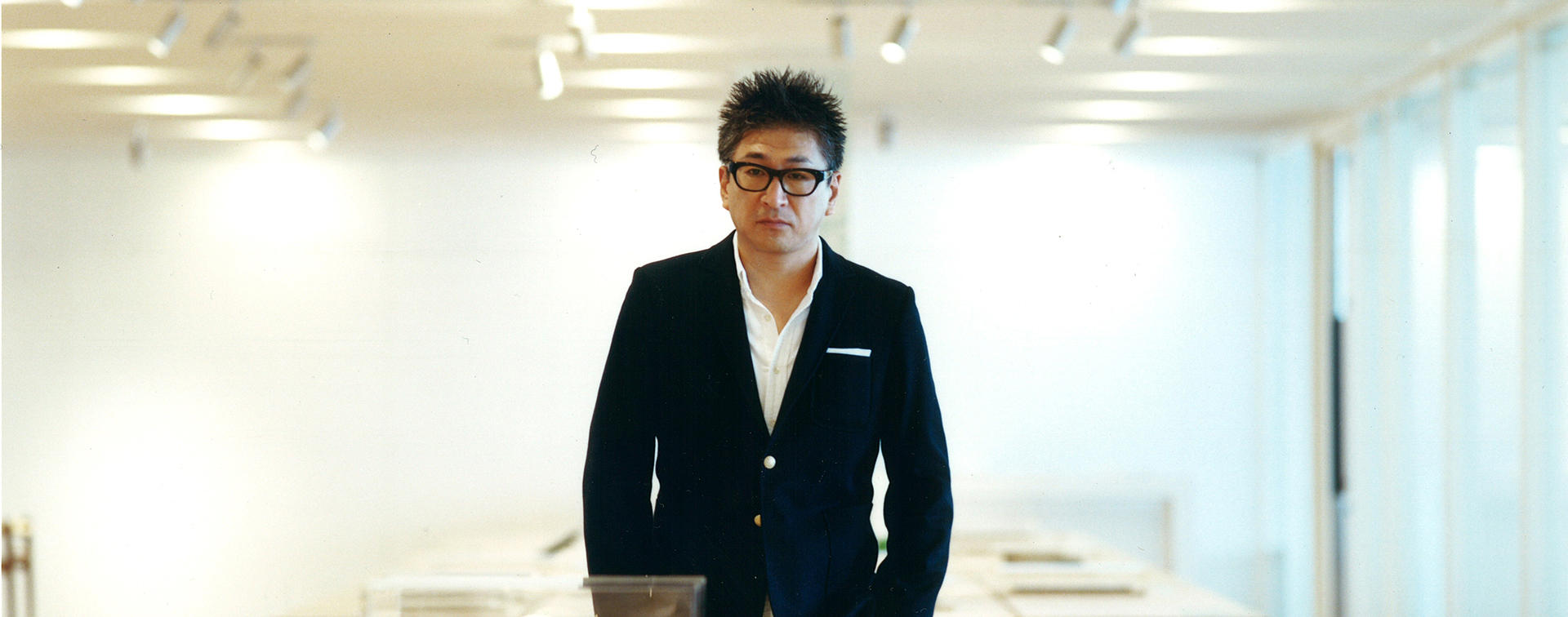
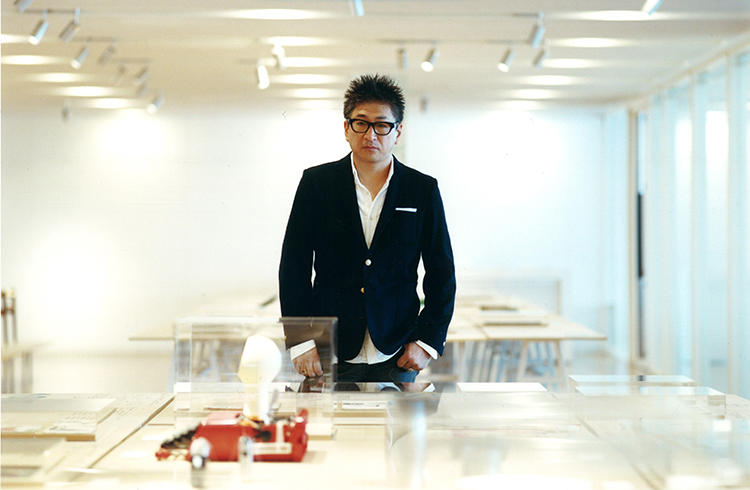
How would you turn Roppongi into an area of Design & Art?
Create a neighborhood which people would want to walk to
- JP / EN
Masamichi Katayama works worldwide as an interior designer, doing 90% of his work overseas. When we interviewed him, he had just returned from Singapore a day earlier. We were rather concerned that holding an interview in the morning would be a tough schedule for Katayama, but when we met him, he told us that he had already attended one meeting. Katayama also said that he is shifting his lifestyle so that his main activities are concentrated in the mornings than in the evenings. During the latter half of the interview, he made a surprising proposal of turning Roppongi into a "morning town." Katayama is currently professor at the Musashino Art University's department of Industrial, Interior and Craft Design. The photos were taken at Tokyo Midtown's Design Hub where the Musashino Art University and Design exhibition is currently being held.
There used to be tremendous energy in Roppongi
When I came to Tokyo at the age of 21, it was the heyday of the bubble economy. At night, the streets in Roppongi were as bright as in the daytime, brimming with people. It was like a Rio carnival. A film came out a few years ago called "Bubble Fiction: Boom or Bust" where a person stops a taxi by waving a 10,000 yen note. There really were people who did that in those days. (laughs) My friends and I didn't have much money so we didn't reap any benefits (from the bubble) but the image of Roppongi initially imprinted on my mind was that of a place with tremendous energy.
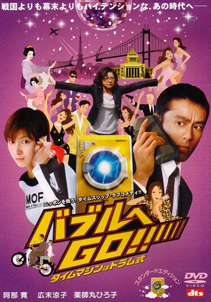
"Bubble Fiction: Boom or Bust"
A 2007 comedy movie. Saddled with debts of 800 trillion yen, the Japanese economy is on the verge of bankruptcy. To try to save the country, the protagonists travel back through time to Tokyo in 1990. Locations such as the Roppongi Crossing and the former Roppongi Square building were filmed in the movie.
Copyright (C) Toho Co.,Ltd. All Rights Reserved.Then the bubble burst, and the crowds stopped coming to Ropponigi, and facilities such as the Roppongi Hills, Tokyo Midtown and the National Art Center, Tokyo were built. The image of Roppongi changed from a place of pleasure to a sophisticated place for grownups, and my own impression of the place changed too. For me, it's now a town where I come for work-related purposes. Uniqlo's Tokyo headquarters are in Tokyo Midtown, and since I'm involved with interior designing of the Uniqlo shops, I come here once a week for meetings. Another connection to Roppongi is the Musashino Art University Design Lounge here at the Design Hub.
But I just come here to get something done, and when it's over, I leave; it's such a pity that I only have that kind of involvement with Roppongi. I would like to enjoy the area in a more personal way, and I have some ideas on how this can be done.
A town where people can take a stroll
The first thing I would do is to make Roppongi a place that people would want to take a stroll. People probably have a strong image of Roppongi as being a place where traffic rushes through the big roads like Gaien-Higashi-dori and Roppongi-dori. But Aoyama Cemetery is quite nearby, and it's possible to walk to Roppongi from Aoyama. Roppongi and the surrounding areas need more perky "tiny dots" - more small shops owned by young promising people who would breathe new life into the town. If the streets could be made more interesting for pedestrians, more people will want to walk to Roppongi instead of getting here by car.
So I envision streets where people can just stroll about. I would create a neighborhood by inviting young people who don't have the money but who are doing interesting things. Roppongi already has famous brand shops set up by big corporations in properly planned zones. It already has the properly planned and exact things, so it now needs more organic, undefined things. For example, if some young people hoping to make a career in fashion opened three or four clothing shops, a network of "tiny dots" would be made, and a neighborhood would naturally be created.
I also think it would be good if there were more casual cafes in Roppongi; cafes that are too flowery can be intimidating. And if there were more casual places, the establishments that are grand would shine even more brightly.
Sow the seeds and the area will begin to grow
Towns tend to end up looking very similar to each other when you plan too much. Traveling to Asia and Europe and America these days, I often get the feeling that each country and each town has similar scenery. Life has become more convenient this way, but I'm not sure that this is a good thing. I think we should try to create places that are more specific to the locale; we should create attractive places that can only be found in Roppongi or that can only be found in Japan. We should invest in the young people who are trying to do interesting things in Roppongi. Otherwise people will not be motivated to travel all the way to Japan and come to this area.
Since I'm an interior designer, I do my work by first looking at the visible and tangible things, and then I try to connect them to the bigger picture. So if I were to develop a town, I would take a step that would have a far-reaching chain reaction - like pushing down a line of dominos. I talked earlier about transforming a town through "tiny dots". In my job of creating spaces, I know from personal experience that such small shops can quickly change the face of a town. If you sow the seeds, a town will change like a plant growing into a tree. After all, that is how a town normally develops.

A town that can be enjoyed for free
For an area to be attractive, it needs to be a place that people can enjoy for free. That's something I always keep in mind. I was surprised to see how the town of Daikanyama changed after the Tsutaya Books opened there. The simple reason behind the transformation is that people can enjoy themselves by just being there. You can have a good time at a bookstore without buying books. You can just walk around to see what kind of books there are; you can pick up a book and read it and be directly involved. The bookstore has helped to draw lots of people, and the people at the clothing stores nearby are really delighted. A town that allows people to enjoy themselves without spending any money becomes commercially successful, and there are uplifting effects on the area as a whole.
I was in charge of comprehensive design work of "Yoyogi Village by kurkku" which opened last year and the interior design of "code kurkku", the Italian restaurant inside. The place used to be the site for the Yoyogi Seminar school buildings. The project was driven by the desire to change the area of Yoyogi. In the garden there are unique plants collected from around the world by plant hunter Seijun Nishihata-san. You don't need to have a meal at the restaurant in the facility to enjoy the garden; you can just walk around and have a good time looking at the plants. The garden provides an opportunity to people to start talking to each other. Places like this where grownups and children, and elderly people and their grandchildren can start talking to each other, can considerably change the way people interact with an area.
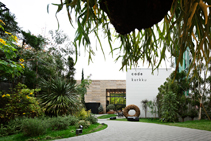
Yoyogi Village by kurkku
A new commercial facility with restaurants whose exterior and interior were variously designed by Japan's leading creators. Events are regularly held.
Yoyogi 1-28-9 Shibuya City, Tokyo
Making environments for easier communication
The opportunity for communication can be art, but art is not important in itself. To me, the aim or significance of making an art town lies in sprinkling cues in the streets that prompt conversations.
The important thing is to create an environment that makes communication easier. I think the whole purpose of my job as a designer is to facilitate communication. I am involved with prompting communication between things and people, or encouraging communication between people through the presence of things. It's possible to create a communication-friendly environment just by making a bench. The Japanese are not good at communicating with each other. That description applies to me too, but everyone actually has the desire to talk a lot, and will do so if given the right environment.
Talking about communication, Roppongi used to be the place for conversation. I mean, during the bubble era, lots of men were coming here to pursue women! (laughs) It would be nice if we could have something like that in a healthier way...
The brand potential of Roppongi
A fact about rebranding is that if a name or brand originally had strength, it will always be able to make a comeback even if it goes through a downhill phase. "Roppongi" is a name that has wonderful brand strength. I think Roppongi could change a lot and become a truly intriguing place once things get moving. Roppongi did not have a reputation before of being an area of design and art, so I think the clear contrast between the past and the present makes it easier to establish a new image.

Roppongi as a morning town
The once-a-week Uniqlo meetings at Tokyo Midtown start at either 8 or 9 in the mornings. They start to work at 7 in the morning at Uniqlo, and by the time I get there, they already finished about two tasks. That's partly why I myself have started going to work early in the mornings. I used to arrive at the office at half past 10, but now I get there at 9. Having started this habit, I find that it works very well. Since I started coming to Tokyo Midtown for the morning meetings, I've noticed that this place has lots of greenery and is a most pleasant place to be in the mornings. So I really wish that the shops would open at an earlier time. Starbucks and some other cafes are about the only establishments in Tokyo Midtown that are open at 8 or 9. The shops don't open until 11. I always feel unfortunate that I don't get the chance to do some shopping after the Uniqlo meeting is over. How about changing Roppongi from a "night town" to a "morning town"? I'm sure there will be consumer demand in the mornings, and Roppongi would liven up in a different way from before.
Eateries that offer proper breakfasts
For Roppongi to become a morning town, it would need many restaurants offering tasty breakfasts. I think there is a particular need for eateries where you can have a proper breakfast meal. Oh, I can just imagine how nice such places would be! Maybe I should start a restaurant of my own that specializes in breakfasts. (laughs) A trend is emerging now for people to take their main meals in the mornings instead of in the evenings. I think it's important to pay attention to what is good for the body and the soul. Recently, I'm having a nutritionist check my lifestyle. Getting instructions from my nutritionist on how to eat and what to eat, I realize that there are no really good eateries near my office. The fare is mostly ramen or curry or udon noodles...I'm always wishing that there were restaurants offering tasty and healthy meals. If there were places in Roppongi where you could have nutritious breakfasts, I'm sure they would become popular. A healthy Roppongi sounds great, don't you think?
Local Roppongi
Having talked so much about Roppongi, it might be out of place to mention this, but I'm from Okayama Prefecture and I feel that while it is important to think about what to do with cities, it's a big problem if the countryside lacks energy. There must be things that can only take place in Roppongi and things that can only be possible in Okayama. Being an Okayama person, I want to do work to help my hometown, and I've started taking some steps in that direction.
The place I come from is in the remote countryside; before being consolidated with other villages and towns, it used to be a "gun" (rural district) and not a town. So far I've tried to evade this, and I didn't want to talk to people about it, but having reached this time in my life, I've come to see that I was mistaken. I realize now that the countryside really has its own special value.
We definitely seem to be living in times where people are becoming interested in local things. Perhaps the word "local" means different things to different people, but I think we need to let the rest of the world know more about Japan - about each of the various localities in Japan such as Okayama and Tokyo and so on. Now is the time to pay attention to something local and specific to each area. I strongly feel that we should take actions before it becomes too late.
Perhaps it would be good to make plans for Roppongi by giving thought to "local Roppongi." It's tough to try to be at the center of things and do grand projects, but if you think of what you can do from the perspective of "local Roppongi", it becomes easier to be experimental and to make all kinds of challenges.
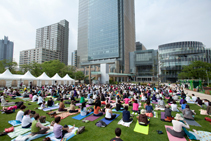
Park Yoga
Irregular yoga classes such as "Morning Yoga" and "Moon Yoga" are held on the Grass Square at Tokyo Midtown. There are programs for beginners and the lawn is sometimes filled with lots of people. (For schedules, please check the "Events" section of the official site.)
Editor's thoughts
The interview for Katayama-san started at 10:00 a.m. When we met him, he had already been to a meeting. We learned that much of his activities are carried out in the mornings, and as to be expected of an early riser, Katayama-san proposed turning Roppongi into a morning town. It would be great if his ideas could be implemented soon. (edit_rhino)



















